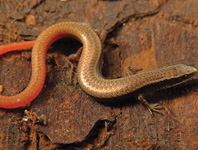Abstract
One known (M. romanicus) and two new species of the genus Metaporcelaimus, collected in natural and semi-natural habitats of Ukraine, are described and illustrated. Metaporcelaimus concinnus sp. n. is characterized by its 3.09–4.58 mm long body, lip region 16.5–19.5 µm broad and visibly wider than the adjacent body, odontostyle 17–19 µm long, neck 745–865 µm long, pharyngeal expansion occupying 62–66% of total neck length, uterus tripartite and 3.9–5.7 times the corresponding body diameter, vulva longitudinal (V = 49–53%), tail conical (44–54 µm, c = 67–94, c’ = 1.0–1.3 in females), spicules 79–86 µm long with strongly bifurcate distal end, and 10–14 irregularly spaced ventromedian supplements without hiatus. Metaporcelaimus declivicaudatus sp. n. is characterized by its 2.88–3.66 mm long body, lip region 23–28 µm broad, odontostyle 24–26 µm long, neck 634–788 µm long, pharyngeal expansion occupying 48–56% of total neck length, uterus tripartite and 3.0–3.4 times the corresponding body diameter long, vulva transverse (V = 51–55%), tail conical (45–65 µm, c = 53–63, c’ = 1.0–1.2) with rounded terminus, spicules 102–113 µm long, and 12–14 spaced ventromedian supplements without hiatus. New information about M. romanicus is also provided, confirming available data about this species.
References
Álvarez-Ortega, S. & Peña-Santiago, R. (2010) Studies on the genus Aporcelaimellus Heyns, 1965 (Dorylaimida: Aporcelaimidae)—material studied by Thorne and Swanger in 1936 but not named. Russian Journal of Nematology, 18, 69–84.
Álvarez-Ortega, S. & Peña-Santiago, R. (2013)Taxonomy of the genus Aporcelaimellus Heyns, 1965 (Nematoda, Dorylaimida, Aporcelaimidae). Zootaxa, 3669 (3), 243–260.
https://doi.org/10.11646/zootaxa.3669.3.3Álvarez-Ortega, S., Subbotin, S.A. & Peña-Santiago, R. (2013) Morphological and molecular characterisation of Californian species of Metaporcelaimus Lordello, 1965 (Dorylaimida, Aporcelaimidae), with a new concept of the genus. Nematology, 15, 251–278.
https://doi.org/10.1163/15685411-00002674Andrássy, I. (1959) Taxonomische Übersicht der Dorylaimen (Nematoda). I. Acta Zoologica Academiae Scientiarum Hungaricae, 5, 191–240.
Andrássy, I. (2001) A taxonomic review of the genera Aporcelaimus Thorne & Swanger, 1936 and Metaporcelaimus Lordello, 1965 (Nematoda, Aporcelaimidae). Opuscula Zoologica Budapestinensis, 33, 7–47.
Courtney, W.D., Polley, D. & Miller, V.L. (1955) TAF, an improved fixative in nematode technique. Plant Disease Reporter, 39, 570–571.
Heyns, J. (1965) On the morphology and taxonomy of the Aporcelaimidae, a new family of dorylaimid nematodes. Entomology Memoirs Department of Agriculture Technical Services Republic of South Africa, nº 10, 1–51.
Loof, P.A.A. & Coomans, A. (1970) On the development and location of the oesophageal gland nuclei in Dorylaimina. Proceedings of the IX International Nematology Symposium, Warsaw, Poland, 1967, 79–161.
Loos, C.A. (1949) Notes on free-living and plant-parasitic nematodes of Ceylon. 6. Journal of the Zoological Society of India, 1, 30–36.
Lordello, L.G.E. (1965) Contribuiçao para o conhocimento dos nematóides brasileiros da familia Dorylaimidae. Thesis Escola Superior Agricultura “Luiz de Queiroz”, Piracicaiba, 68 pp.
Man, J.G. de (1880) Die einheimischen, frei in der reinen Erde und im süssen Wasser lebenden Nematoden. Tijdschrift Nederlandsche dierkundige Vereeniging, 5, 1–104.
Peña-Santiago, R., Abolafia, J. & Álvarez-Ortega, S. (2014) New proposal for a detailed description of the dorylaim spicule (Nematoda: Dorylaimida). Nematology, 16, 1091–1095.
https://doi.org/10.1163/15685411-00002834Popovici, P. (1978) New nematodes species (Dorylaimoidea) from Romania. Nematologica, 24, 404–411.
https://doi.org/10.1163/187529278X00533Seinhorst, J.W. (1959) A rapid method for the transfer of nematodes from fixative to anhydrous glycerine. Nematologica, 4, 67–69.
https://doi.org/10.1163/187529259X00381Solov’eva, G.I. (1986) Ekologiya pochvennykh nematod (Ecology of Soil Nematodes). Nauka, Leningrad, 247 pp. [In Russian]
Thorne, G. (1974) Nematodes of the Northern Great Plains. Part II. Dorylaimoidea in part (Nemata: Adenophorea). South Dakota State University Agriculture Experimental Station Technical Bulletin, nº 41, 1–120.
Thorne, G. & Swanger, H.H. (1936) A monograph of the nematode genera Dorylaimus Dujardin, Aporcelaimus n. gen., Dorylaimoides n. gen., and Pungentus n. gen. Capita Zoologica, 6, 1–223.
Vinciguerra, M.T. & Giannetto, L. (1983) Three new species of Dorylaimida (Nematoda) from Italian terrestrial ecosystems. Animalia, 10, 283–289.

